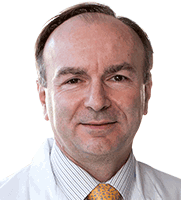03
Jul
2017
17:00
BST
Webinar
Use of Intravascular Ultrasound in the Assessment of Chronic Total Occlusions
-
Views:
 1713
1713
-
Likes:
 0
0
Overview
Prof. Gerald Werner (Klinikum Darmstadt, Germany) presents this webinar on the use of IVUS imaging for the assessment of chronic total occlusions.
This webinar is intended to educate interventional cardiologists, interventional fellows and related healthcare professionals, and discusses and analyses the role of intravascular imaging during PCI for chronic total occlusions, focusing on the main applications in this context from lesion assessment to stent sizing and optimisation.
The webinar/clinical case scenarios will:
- Provide the background for chronic total occlusions and its treatment
- Identify the challenges associated with use of PCI for chronic total occlusions
- Highlight the role and use of IVUS in PCI, including rationale for its use versus coronary angiography
- Discuss clinical evidence for the use of IVUS in chronic total occlusions
- Present a workflow algorithm, outlining the steps involved in the practical use of IVUS in chronic total occlusions, in different scenarios (for different approaches such as antegrade and retrograde approaches and for stent optimisation)
- Discuss real-life case studies, incorporating the relevant components of the workflow algorithm relating to each case
Faculty:

Gerald Werner
This webinar is supported by

Educational Objectives
This webinar is to inform and educate interventional cardiologists and cardiologists on:
- Interventions historically and currently used for the treatment of chronic total occlusions
- Challenges associated with existing intervention for chronic total occlusions
- The advantages and roles of IVUS imaging in chronic total occlusion interventions
- Clinical evidence to support the use of IVUS in the chronic total occlusion setting
- A workflow algorithm developed to facilitate operators in using IVUS imaging in the various scenarios of chronic total occlusion intervention
Target Audience
- Interventional Cardiologists
- Interventional Fellows
- Cathlab Nurses Technicians and Managers
Faculty Biographies

Gerald Werner
Professor Gerald Werner has been Director of Cardiology and Intensive Care at the Darmstadt Clinic, a teaching hospital of the University of Frankfurt, since 2005. This post followed a period of 7 years as Professor of Cardiology at the Friedrich Schiller University Jena, where he was Deputy Director of the Cardiology Department and Head of the catheter laboratory. Prior to this, Professor Werner held other positions at the University of Göttingen (Georgia Augusta) including Consultant in internal medicine-cardiology and Head of the echo cardiology laboratory.
Professor Werner’s research interests focus on the interventional therapy of coronary artery disease, including intravascular ultrasound, chronic total occlusions (CTOs) and collateral physiology, and the applications of lasers in interventional cardiology. He is a pioneer of coronary imaging by ultrasound; his earliest publications in this field date back to 1991, and he was among the first to describe the phenomenon of intramural coronary haematoma, and subintimal vessel pathways during recanalisation of a chronic coronary occlusion. He received the Franz–Maximilian Groedel Award of the German Cardiac Society (GCS) for his work on collateral physiology in CTOs. He has published over 150 original papers and is Fellow of the European Society of Cardiology (ESC), American College of Cardiology (ACC) and the Society of Cardiovascular Angiography and Interventions (SCAI). He is also co-Founder and past-President of the EuroCTO club.
Key References
1. Yang SS, et al. Eur Rev Med Pharmacol Sci 2015;19:1101–16
2. Prasad A, et al. J Am Coll Cardiol 2007;49:1611–8;
3. St Goar FG, et al. J Am Coll Cardiol 1991;18:952–8
4. Roy P, et al. Eur Heart J 2008;29:1851–7
5. Furuichi S, et al. Catheter Cardiovasc Interv 2007;70:856–9
6. Nakatani S, et al. Expert Rev Med Devices 2013;10:735–49
7. Authors/Task Force members, Windecker S, et al. Eur Heart J 2014;35:2541–619
8. Chieffo A, et al. Am Heart J 2013;165:65–72
9. Hong SJ, et al. Am J Cardiol 2014;114:534–40
10. Tian NL, et al. EuroIntervention 2015;10:1409–17
11. Kim BK, et al. Circ Cardiovasc Interv 2015;8:e002592





